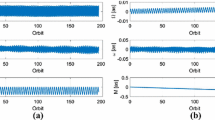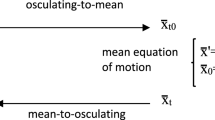Abstract
Analytical integration in Artificial Satellite Theory may benefit from different canonical simplification techniques, like the elimination of the parallax, the relegation of the nodes, or the elimination of the perigee. These techniques were originally devised in polar-nodal variables, an approach that requires expressing the geopotential as a Pfaffian function in certain invariants of the Kepler problem. However, it has been recently shown that such sophisticated mathematics are not needed if implementing both the relegation of the nodes and the parallax elimination directly in Delaunay variables. Proceeding analogously, it is shown here how the elimination of the perigee can be carried out also in Delaunay variables. In this way the construction of the simplification algorithm becomes elementary, on one hand, and the computation of the transformation series is achieved with considerable savings, on the other, reducing the total number of terms of the elimination of the perigee to about one third of the number of terms required in the classical approach.
Similar content being viewed by others
Notes
Approaches based on non-osculating elements are also possible (Gurfil 2004).
Definitions related to the Lie transformations lingo may be consulted in the book of Ferraz-Mello (2007), for instance.
Note that, after the different transformations, the transformed Hamiltonian continues to represent perturbed Keplerian motion, and hence the usual relations of elliptic motion still apply in spite of the different meaning of the prime variables from the original ones.
References
Abad, A., San-Juan, J.F., Gavín, A.: Short term evolution of artificial satellites. Celest. Mech. Dyn. Astron. 79(4), 277–296 (2001)
Alfriend, K.T., Coffey, S.L.: Elimination of the perigee in the satellite problem. Celest. Mech. 32(2), 163–172 (1984)
Arnold, V.I.: Mathematical Methods of Classical Mechanics, 2nd edn. Springer, New York (1989)
Battin, R.H.: An Introduction to the Mathematics and Methods of Astrodynamics. American Institute of Aeronautics and Astronautics, Reston (1999)
Broucke, R.A.: Numerical integration of periodic orbits in the main problem of artificial satellite theory. Celest. Mech. Dyn. Astron. 58(2), 99–123 (1994)
Brouwer, D.: Solution of the problem of artificial satellite theory without drag. Astron. J. 64, 378–397 (1959)
Brouwer, D., Clemence, G.M.: Methods of Celestial Mechanics. Academic Press, New York and London (1961)
Celletti, A., Negrini, P.: Non-integrability of the problem of motion around an oblate planet. Celest. Mech. Dyn. Astron. 61, 253–260 (1995)
Claes, H.: Analytical theory of earth’s artificial satellites (A.T.E.A.S.). Celest. Mech. 21, 193–198 (1980)
Coffey, S., Alfriend, K.T.: An analytical orbit prediction program generator. J. Guid. Control Dyn. 7, 575–581 (1984)
Coffey, S., Deprit, A.: Third-order solution to the main problem in satellite theory. J. Guid. Control Dyn. 5(4), 366–371 (1982)
Coffey, S.L., Deprit, A., Deprit, E.: Frozen orbits for satellites close to an earth-like planet. Celest. Mech. Dyn. Astron. 59(1), 37–72 (1994)
Coffey, S.L., Deprit, A., Miller, B.R.: The critical inclination in artificial satellite theory. Celest. Mech. Dyn. Astron. 39(4), 365–406 (1986)
Cushman, R.: Reduction, Brouwer’s Hamiltonian and the critical inclination. Celest. Mech. 31(4), 401–429 (1983).; errata: 33(3), 297 (1984)
Cutting, E., Frautnick, J.C., Born, G.H.: Orbit analysis for SEASAT-A. J. Astronaut. Sci. 26, 315–342 (1978)
Danby, J.M.A.: Motion of a satellite of a very oblate planet. Astron. J. 73(10), 1031–1038 (1968)
Deprit, A.: Canonical transformations depending on a small parameter. Celest. Mech. 1(1), 12–30 (1969)
Deprit, A.: The elimination of the parallax in satellite theory. Celest. Mech. 24(2), 111–153 (1981)
Deprit, A.: Delaunay normalisations. Celest. Mech. 26(1), 9–21 (1982)
Deprit, A., Ferrer, S.: Simplifications in the theory of artificial satellites. J. Astronaut. Sci. 37, 451–463 (1989)
Deprit, A., Rom, A.: The main problem of artificial satellite theory for small and moderate eccentricities. Celest. Mech. 2(2), 166–206 (1970)
Deprit, A., Palacián, J.F., Deprit, E.: The relegation algorithm. Celest. Mech. Dyn. Astron. 79(3), 157–182 (2001)
Ferrer, S., San-Juan, J.F., Abad, A.: A note on lower bounds for relative equilibria in the main problem of artificial satellite theory. Celest. Mech. Dyn. Astron. 99(1), 69–83 (2007)
Ferraz-Mello, S.: Canonical Perturbation Theories, Degenerate Systems and Resonance. Astrophysics and Space Science Library, vol. 345. Springer, New York (2007)
Gurfil, P.: Analysis of \(J_2\)-perturbed motion using mean non-osculating orbital elements. Celest. Mech. Dyn. Astron. 90(3–4), 289–306 (2004)
Healy, L.M.: The main problem in satellite theory revisited. Celest. Mech. Dyn. Astron. 76(2), 79–120 (2000)
Hori, G.: Theory of general perturbation with unspecified canonical variables. Publ. Astron. Soc. Jpn. 18(4), 287–296 (1966)
Irigoyen, M., Simo, C.: Nonintegrability of the \(J_2\) problem. Celest. Mech. Dyn. Astron. 55(3), 281–287 (1993)
Kozai, Y.: The motion of a close earth satellite. Astron. J. 64(11), 367–377 (1959)
Kozai, Y.: Second-order solution of artificial satellite theory without air drag. Astron. J. 67(7), 446–461 (1962)
Krylov, N., Bogoliubov, N.N.: Introduction to Nonlinear Mechanics. Princeton University Press, Princeton, New York (1947)
Lara, M., San-Juan, J.F., López-Ochoa, L.M.: Averaging tesseral effects: closed form relegation versus expansions of elliptic motion. Mathematical Problems in Engineering 2013(Article ID 570127), 1–11 (2013a)
Lara, M., San-Juan, J.F., López-Ochoa, L.M.: Precise analytical computation of frozen-eccentricity, low Earth orbits in a tesseral potential. Mathematical Problems in Engineering 2013 (Article ID 191384), 1–13 (2013b)
Lara, M., San-Juan, J.F., López-Ochoa, L.M.: Proper averaging via parallax elimination (AAS 13–722). Adv. Astronaut. Sci. 150, 315–331 (2014)
Lyddane, R.H.: Small eccentricities or inclinations in the Brouwer theory of the artificial satellite. Astron. J. 68, 555–558 (1963)
Morrison, J.A.: Generalized method of averaging and the von Zeipel method. In: AIAA Paper N0. 65–687, American Institute of Aeronautics and Astronautics, USA (1965)
Nayfeh, A.H.: Perturbation Methods. Wiley-VCH Verlag GmbH & Co. KGaA, Weinheim (2004)
Palacián, J.F., San-Juan, J.F., Yanguas, P.: Analytical theory for the Spot satellite. Adv. Astronaut. Sci. 95, 375–382 (1997)
Pars, L.A.: A Treatise on Analytical Dynamics, 1st edn. Heinemann, London (1965)
Rosborough, G.W., Ocampo, C.: Influence of higher degree zonals on the frozen orbit geometry. Adv. Astronaut. Sci. 76, 1291–1304 (1992)
Sanders, J.A., Verhulst, F.: Averaging Methods in Nonlinear Dynamical Systems. Springer, New York (1985)
San-Juan, J.F.: ATESAT: Automatization of theories and ephemeris in the artificial satellite problem. CNES report no. CT/TI/MS/MN/94-250, Toulouse, France (1994)
San-Juan, J.F.: ATESAT: review and improvements. Study of a family of analytical models of the artificial satellite generated by ATESAT and their numerical validation versus PSIMU and MSLIB. CNES report no. DGA/T/TI/MS/MN/97-258, Toulouse, France (1998)
San-Juan, J.F., López-Ochoa, L.M., López, R.: MathATESAT: a symbolic-numeric environment in astrodynamics and celestial mechanics. Lect. Notes Comput. Sci. 6783(2), 436–449 (2011)
Segerman, A.M., Coffey, S.L.: An analytical theory for tesseral gravitational harmonics. Celest. Mech. Dyn. Astron. 76(3), 139–156 (2001)
Shapiro, B.E.: Phase plane analysis and observed frozen orbit for the Topex/Poseidon mission. Adv. Astronaut. Sci. 91, 853–872 (1996)
von Zeipel, H.: Research on the motion of minor planets (recherches sur le mouvement des petites planètes). NASA Translation: NASA TT F-9445 (1965)
Acknowledgments
Part of this research has been supported by the Government of Spain (Projects AYA 2009-11896, AYA 2010-18796, and grant Fomenta 2010/16 of Gobierno de La Rioja).
Author information
Authors and Affiliations
Corresponding author
Appendix
Appendix
The integration “constant” \(V_2\) is
The term \(W_3\) of the generating function of the elimination of the perigee is
where the integration constant \(V_3\) is
Rights and permissions
About this article
Cite this article
Lara, M., San-Juan, J.F. & López-Ochoa, L.M. Delaunay variables approach to the elimination of the perigee in Artificial Satellite Theory. Celest Mech Dyn Astr 120, 39–56 (2014). https://doi.org/10.1007/s10569-014-9559-2
Received:
Revised:
Accepted:
Published:
Issue Date:
DOI: https://doi.org/10.1007/s10569-014-9559-2




